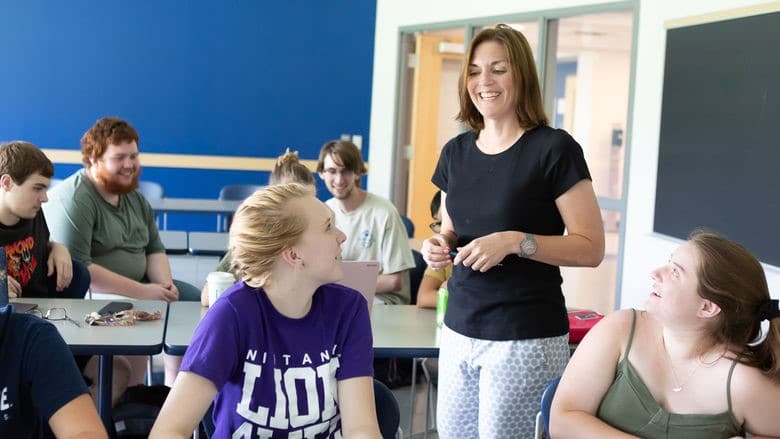
A class lesson is designed to spark creativity, interest and passion for academics in students. A single lecture can mold and shape the perspectives of numerous students and expand their knowledge drastically.
A class lesson conducted by a qualified teacher can be even more impactful if the students retain and remember the information in unique and different ways, for example, through project-based work or science experiments. These diverse activities give a break from the monotony of class routine and encourage students to have greater participation. It’s crucial to ensure that students don’t become passive learners but fully engage with the lesson plan.
There are multiple ways of ensuring that students actively participate in their education. For example, through assignments, quizzes and tests you can check their ability to remember important information and how well they understand core concepts. However, knowledgeable learning does not only concern memory and rote learning. It’s about empowering students to feel confident about their skills and to motivate them to be the best. Hence, teachers can use a plethora of strategies to help students progress and thrive as individuals and as a whole class.
Group work is a crucial step toward attaining well-rounded individuals who can coordinate and collaborate well with other students and achieve the highest level of excellence individually as well. How can you ensure this? There are different ways you can divide your class into groups, it is beneficial as a teacher to know the strengths and weaknesses of each student to group them effectively in terms of workload and self-development.
Here are some strategies you can use to divide your class successfully into groups for a project, assignment or activity:
Skill-based
This is a great way to manage and group your class according to their subject or skill preferences. The skills could vary from problem solving, speaking, reading, writing etc. Groups can be formed through same skills or variations in their skills.
If you group students who have a similar aptitude, for example, students who are all impeccable at solving math solutions are in one group, while avid readers are in another, ultimately you can assign an ability-specific task to each group and enhance their individual performance through working together. This way you can figure out your students’ weaknesses and work on them individually or collectively.
Similarly, you can also divide your students in contrast with their skills, for example, a group of varied skills and assign them a task that would require them to employ all of their abilities. By doing so, you’ll be allowing your students to actively engage with one another, assist each other in areas of weakness and share ideas. This will make your class more knowledgeable of each other’s aptitude and create a balanced environment of learning.
Spontaneous Grouping
You can do randomized grouping in multiple ways. For example, you can ask students to turn right and pair up with the partner sitting beside them, and the entire row could form a group.
A rotational system could also be set in place. This is where not one individual has the same group for too long. They keep switching around the groups. Students can sit in a circle, and each portion of the ring rotates clockwise or anti-clockwise while the other side remains stationary.
Mixing and randomizing groups have a significant advantage. It is seen as impartial and allows each student to contribute and stay involved. There is also an alphabetical rotational system that you can employ, where you can assign groups based on their alphabetical order of names and keep reorganizing or shuffling based on their name letters. This is where a teacher can get the most creative and innovative, and connect different students through this technique.
For example, a teacher could design colored cards and randomly distribute them to students or ask them to select the color they want out of red, blue, yellow and green. Once all your students have cards, all the blue cardholders will be one group, and students with red cards will be another and so on.

Weekly Groups
This is a fun interactive technique that will allow your students to stay active and familiarize themselves with all the students in class. You can assign each student to a specific partner or group every day of the week or for one week and then switch the partner or group for the next week or day.
For example, the entire first week of October will be reserved for one group, the second week the groups will be randomly mixed and assigned. You can also do this with pairs of students and assign one student partner for each day of the week.
Class Games for Grouping
Initiate different techniques that will make your class more exciting and also make students feel welcomed and appreciated. Your effort and time will be respected in class and the students will find a way to reciprocate (trust me!). Hence, organize small class activities by dividing your class into groups for any work or assignment. This way the students won’t feel disappointed or upset over the selection of their group members. For example:
- Counting Off– This activity is exciting since it allows your class to stay alert. If you want five groups, you can count off the numbers backward, five, four, three, two and one, and assign them numbers accordingly. Moreover, you can add a little teaching moment in this by dividing based on any authors, historians and important characters they have become familiar with in their previous lessons. For example, Newton, Einstein, Galileo, Hooke, etc.
- Cluster Game– In this activity, you ask all your students to stand up next to their seats, and you say out a number, for example, three. The students will quickly form a cluster of three. The students left out will get a bonus assignment or the choice of selecting a group.
- Synonym/Antonym– This technique could also be used to teach students essential words and enhance their English language skills. You simply write synonyms on cards, randomly give them out to your students, and pair them up according to the synonyms. You can do this with antonyms as well.
- Popular Pairings– This is an educative task that will allow your students to think and find their partners. You could create smart cards by writing associations of words and pairs. For example, with Einstein, you could create a pair card of E=MC^2.
- Birthday Partners or Groups- This is the most straightforward technique you can use to divide your class. Ask their birthday months and dates and group them according to the same dates or same months.
Student Autonomy
Give your students the task of organizing themselves into groups of their choice. This will give them confidence in their ability to decide. The students can choose their friends, which happens most of the time. However, remind them that their input will be graded individually and collectively hence they cannot slack off and have to produce good work. You have to trust your students to make the appropriate choice and decide what is best for them.
You can play a role in this by adding a few restrictions in helping them narrow down their choices, for example, they cannot have the same group as last time or pair up with the last person they were with. Moreover, you can employ different techniques that could give them the choice of selection and avoid repetition and unproductivity. For example, you could ask your students to create a personal list of contacts in the class and only allow two friends on a list. Use this list as a reference for diving groups or pairing up. Tuesday’s work will be with the 4th contact on the list.
You could assign responsibility to your students by giving them the choice of task or work selection. Students can choose what work they would prefer to do, for example, if it’s an assignment about rainforests in North America, you could divide tasks into categories of research, report writing, verbal presentation and creating visual aid. Similarly, you could break down this assignment into different topics such as the impact of global warming, wildlife in the rainforests, types of trees, etc. The students could select which task they want to do and what topic they will prefer doing.
In addition to this, several other ways could ensure both, the student and the teacher’s autonomy, in forming groups. For example, you could give a quiz or survey to your class to test each student’s general aptitude and skillset. You could also add personal questions such as ‘what is your favorite season?’ or ‘what is your favorite food?’ and divide them according to their test scores. Adding personal questions can make you aware of other students, and their commonalities can help make group formation easier for future references.
You can use the test scorers to assign groups that would be mutually beneficial strategically. For example, placing all the low scoring students in a single group would not be a great learning experience for them. They might feel discomfort putting trust in each other’s abilities and not advance as a group or individually.
The above tips and examples are there to help you achieve the best outcome for your class. It is your responsibility as a teacher to know how to control and manage your students successfully to help them learn and be comfortable in their surroundings. Remember that in a school, students are quick to form groups outside a classroom as well. They may have preliminary contentions, existing disputes or strong friendships with someone in the class. Hence, you must be aware of any such discrepancies and ensure that personal conflicts or companionships do not interrupt classwork or projects.
Cooperative learning has a multitude of benefits; make sure you are keen on achieving some of those objectives. You will discover that there is no one way that is the best option for a specific group of students every time. It is optimal to use these methods interchangeably and switch around your strategies. Try student autonomy and if that does not produce the desired results, try selecting or forming the groups yourself by involving them in class games or testing their skills and splitting them accordingly.
Lastly, remember that you are the authority figure in the room, the ultimate decision of how the groups are formed depends on you. Hence, do not give in to your students’ persuasion and disobedience, which is likely to follow if they are unhappy with their groups. Your decision should be calculated and well thought-out. Do not change your final selections based on your class’s demands.



1 Comment